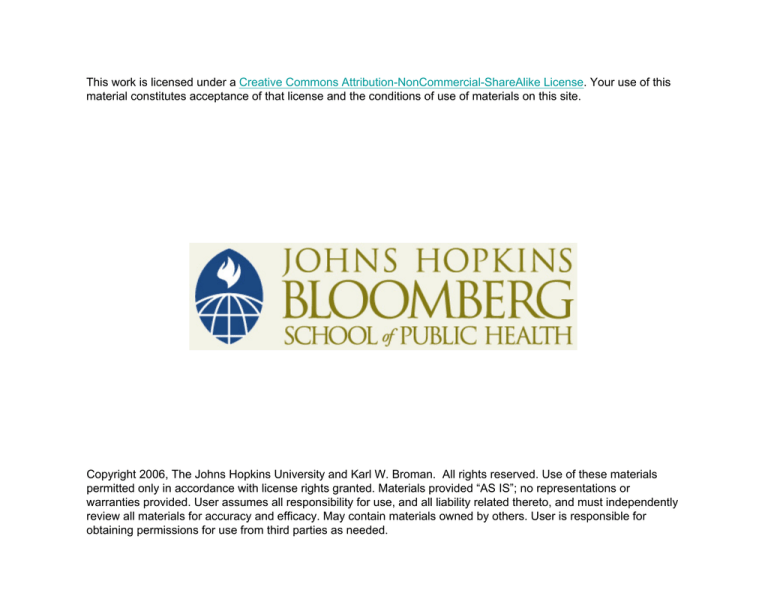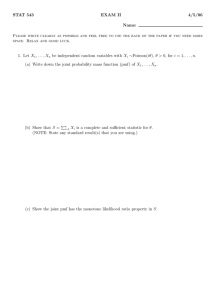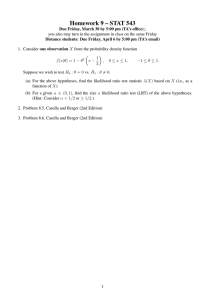
This work is licensed under a Creative Commons Attribution-NonCommercial-ShareAlike License. Your use of this
material constitutes acceptance of that license and the conditions of use of materials on this site.
Copyright 2006, The Johns Hopkins University and Karl W. Broman. All rights reserved. Use of these materials
permitted only in accordance with license rights granted. Materials provided “AS IS”; no representations or
warranties provided. User assumes all responsibility for use, and all liability related thereto, and must independently
review all materials for accuracy and efficacy. May contain materials owned by others. User is responsible for
obtaining permissions for use from third parties as needed.
r x k tables
Blood type
Population
A
B
AB
O
Florida
122
117
19
244
Iowa
1781 1351 289 3301 6721
Missouri
353
269
60
502
713 1395
2256 1737 367 4258 8618
Question: Same distribution of blood types in each population?
Underlying probabilities
Underlying probabilities
Observed data
1
2 ···
k
1
2 ···
k
1 n11 n12 · · · n1k n1+
1 p11 p12 · · · p1k p1+
2 n21 n22 · · · n2k n2+
.. . . . ..
..
.. ..
2 p21 p22 · · · p2k p2+
.. . . . ..
..
.. ..
r nr1 nr2 · · · nrk nr+
r pr1 pr2 · · · prk pr+
n+1 n+2 · · · n+k n
H0:
pij = pi+ × p+j
p+1 p+2 · · · p+k 1
for all i,j
Expected counts
Expected counts
Observed data
A
B
AB
O
F
122
117
19
244
I
1781 1351 289 3301 6721
M 353
269
60
502
713 1395
A
B
AB
O
F
131
101
21
248
I
1759 1355 286 3321 6721
M 365
2256 1737 367 4258 8618
Expected counts, under H0:
χ2
eij = ni+ × n+j/n
AB
O
F
122
117
19
244
I
1781 1351 289 3301 6721
502
713 1395
2256 1737 367 4258 8618
X2 statistic =
P (obs−exp)2
LRT statistic = 2 ×
exp
P
for all i,j
Expected counts
B
60
689 1395
and LRT statistics
A
269
59
2256 1737 367 4258 8618
Observed data
M 353
281
502
A
B
AB
O
F
131
101
21
248
I
1759 1355 286 3321 6721
M 365
281
59
502
689 1395
2256 1737 367 4258 8618
= · · · = 5.64
obs ln(obs/exp) = · · · = 5.55
Asymptotic approximation
If the sample size is large, the null distribution of the χ2 and likelihood ratio test statistics will approximately follow a
χ2 distribution with (r – 1) × (k – 1) d.f.
In the example, df = (3 – 1) × (4 – 1) = 6
X2 = 5.64
LRT = 5.55
−→
P = 0.46.
−→
P = 0.48.
Fisher’s exact test
Observed data
1
2 ···
k
1 n11 n12 · · · n1k n1+
• Assume H0 is true.
2 n21 n22 · · · n2k n2+
.. ..
.. . . . ..
..
• Condition on the marginal counts
Q
• Then Pr(table) ∝ 1/ ij nij!
r nr1 nr2 · · · nrk nr+
n+1 n+2 · · · n+k n
• Consider all possible tables with the observed marginal counts
• Calculate Pr(table) for each possible table.
• P-value = the sum of the probabilities for all tables having a
probability equal to or smaller than that observed.
Fisher’s exact test: The example
Observed
P−value = 48%
53916
53918
53920
53922
53924
53926
53928
∑ log(nij!)
Since the number of possible tables can be very large,
we often must resort to computer simulation.
Another example
Survival following treatment in five mouse strains
Survive
Strain
No Yes
A
15
5
B
17
3
C
10 10
D
17
3
E
16
4
Question: Is the survival rate the same for all strains?
Results
Expected under H0
Observed
Survive
Survive
Strain
No Yes
Strain
No Yes
A
15
5
A
15
5
B
17
3
B
15
5
C
10 10
C
15
5
D
17
3
D
15
5
E
16
4
E
15
5
X2 = 9.07
−→
LRT = 8.41
−→
P = 5.9%
[What is the df?]
P = 7.8%
Fisher’s exact test: P = 8.7%
All pairwise comparisons
N Y
N
Y
A 15 5 −→ P=69%
B 17 3 −→ P=4.1%
B 17 3
C 10 10
N
Y
N Y
A 15 5 −→ P=19%
B 17 3 −→ P=100%
C 10 10
D 17 3
N Y
Y
C 10 10 −→ P=9.6%
E 16 4
N Y
D 17 3 −→ P=100%
E 16 4
N Y
A 15 5 −→ P=69%
B 17 3 −→ P=100%
D 17 3
E 16 4
N Y
N
N
Y
A 15 5 −→ P=100%
C 10 10 −→ P=4.1%
E 16 4
D 17 3
Is this a good thing to do?
Two-locus linkage in an intercross
BB Bb bb
AA 6 15 3
Aa 9 29 6
aa 3 16 13
Are these two loci linked?
General test of independence
Observed data
Expected counts
BB Bb bb
BB Bb bb
AA 6 15 3
AA 4.3 14.4 5.3
Aa 9 29 6
Aa 7.9 26.4 9.7
aa 3 16 13
aa 5.8 19.2 7.0
χ2 test:
LRT test:
X2 = 10.4
−→
LRT = 9.98
Fisher’s exact test:
P = 3.5%
−→
P = 4.6%
[df = 4]
P = 4.1%
A more specific test
Underlying probabilities
Observed data
BB Bb bb
BB
AA 6 15 3
AA
Aa 9 29 6
Aa
aa 3 16 13
aa
H0: θ = 1/2
−→
versus
Bb
bb
1
1
2
4 (1 − θ)
2 θ(1 − θ)
1 2
1
2
2 θ(1 − θ) 2 [θ + (1 − θ) ]
1
1 2
4θ
2 θ(1 − θ)
1 2
4θ
1
2 θ(1 − θ)
1
2
4 (1 − θ)
Ha: θ < 1/2
Use a likelihood ratio test.
• Obtain the general MLE of θ.
• Calculate the LRT statistic = 2 ln
n
Pr(data | θ̂)
Pr(data | θ=1/2)
o
• Compare this statistic to a χ2(df = 1).
Results
BB Bb bb
AA 6 15 3
Aa 9 29 6
aa 3 16 13
MLE:
θ̂ = 0.359
LRT statistic:
LRT = 7.74
−→
P = 0.54%
[df = 1]
• Here we assume Mendelian segregation, and that deviation
from H0 is “in a particular direction.”
• If these assumptions are correct, we’ll have greater power to
detect linkage using this more specific approach.
Sample size determination
−→
We seek to demonstrate that strains A and B differ in their
survival rates following treatment.
How many mice from each group to study?
Generally, our goal is to have 80% power to detect a “meaningful”
difference.
Power depends on. . .
• Structure of the experiment
• Method of analysis
• Sample size
• Chosen significance level (α)
• The underlying truth
We usually seek to determine the sample size that will give us
80% power to detect the smallest difference that we consider
meaningful.
Calculating power
To determine power, we need:
1. The null distribution of the test statistic (so that we can
determine the appropriate critical value).
2. The distribution of the test statistic under the alternative
hypothesis.
For the t-test, there were analytical formulas for these.
For testing independence in a 2 x 2 table, we must resort to computer simulation.
Power in 2 x 2 tables
Suppose we assay 20 individuals from each strain.
Let pA = Pr(survive treatment | strain A) and
pB = Pr(survive treatment | strain B).
To estimate power:
1. Simulate data for some specified pA and pB.
2. Calculate the chosen test statistic.
3. Calculate the corresponding P-value.
4. Repeat 1–3 many times (say 250).
5. The estimated power = prop’n of P-values ≤ 0.05
Power in 2 x 2 tables
The case n=20 per group and pA = 30%.
[results based on 10,000 simulations]
100
80
Power
60
40
χ2 test
LRT
20
Fisher
0
0
20
40
60
80
100
40
50
pB (%)
Power of χ2 test
100
pA = 10%
pA = 30%
pA = 50%
80
Power
60
40
20
0
0
10
20
30
pB − pA (in %)
To get the sample size. . .
Results χ2 test for pA = 30% and pB = 50%.
100
80
Power
60
40
20
0
20
40
60
80
100
120
140
Sample size (n)
Notes
• There are formulas available for all sorts of different statistical tests and experimental situations.
• Simulations are time-consuming (and require programming), but can be used in virtually any situation.
• 250 simulation replicates is usually enough to get a good estimate of power, but for making power comparisons between
different statistical methods, many more replicates are often
necessary.
• Power is an important criterion in choosing between different
statistical tests (such as the χ2 test versus Fisher’s exact
test).
Another example
N Y
• Survival following treatment in 5 mouse
strains.
A
B
• Seek to demonstrate that the strains differ.
C
• Power for the case of 20 individuals per
strain?
D
E
• We might focus on the case that strains A–D are the same, but
strain E is different (the worst possible case).
• We must then specify Let pA = Pr(survive treatment | strain A)
and pE = Pr(survive treatment | strain E).
Power for this example
The case n=20 per group, and pA = pB = pC = pD = 30%.
100
80
Power
60
40
χ2 test
LRT
20
Fisher
0
0
20
40
60
pE (%)
80
100
Comparison to 2 x 2 table
Comparing all 5 strains versus comparing just strains A and E.
(Considering just the likelihood ratio test.)
100
80
Power
60
40
5x2 table
2x2 table
20
0
0
20
40
60
80
100
pE (%)
Final points
• Assumptions underlying tests in contingency tables:
1. Data are a random sample from some population or populations.
– Two or more independent samples observed with respect to one variable
– One random sample observed with respect to two variables.
2. Observations within a sample are independent.
• Ordinal data may require different techniques
None Some A lot
A
B





